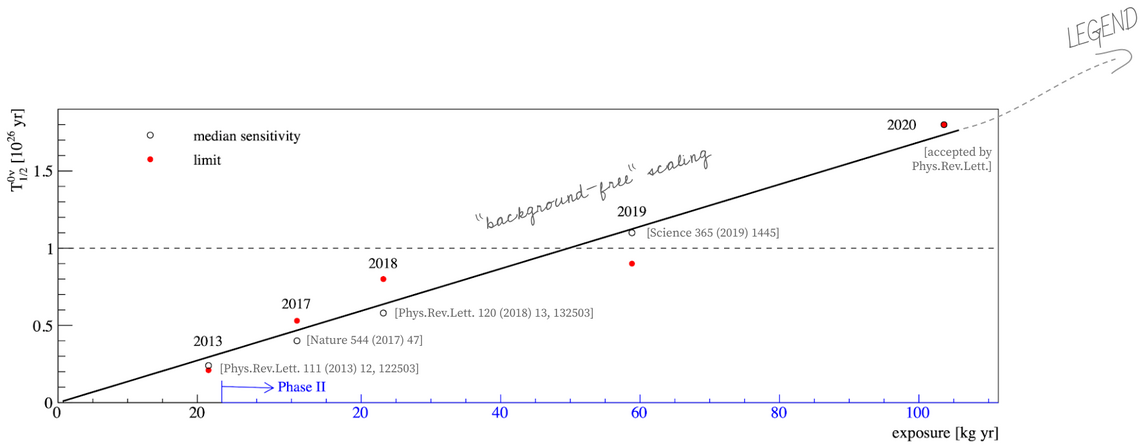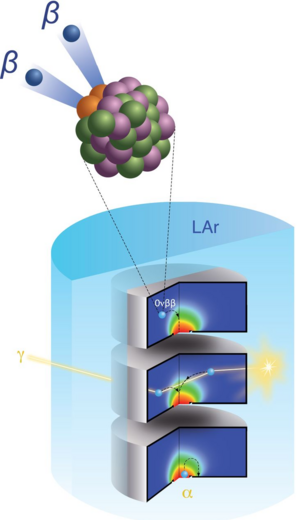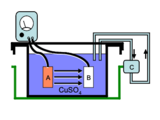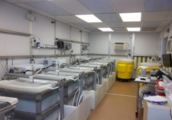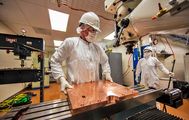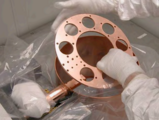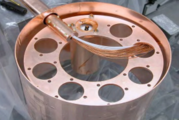GERDA results from the past years
Zero-Background Regime
In the "zero-background" regime the sensitivity increases lineraly with the exposure. Previous results from GERDA have proven that a 76Ge experiment can operate in this regime.
Setting the Stage for LEGEND
GERDA & MAJORANA-DEMONSTRATOR
LEGEND is building on the success of GERDA and MAJORANA. GERDA and the MAJORANA-DEMONSTRATOR experiments use germanium detectors made from isotropically modified material enriched to ~85% 76Ge. These two leading experiments bring together their long experience in the field to help build LEGEND.
The main design feature of GERDA is to use the cryogenic liquid argon1 to shield against gamma radiation, the dominant background in earlier experiments. High purity germanium detectors are immersed directly in the cryogenic liquid which also acts as the cooling medium. The cryogenic volume is surrounded by a buffer of ultra-pure water acting as an additional gamma and neutron shield.
MAJORANA has achieved background levels similar to GERDA by the production of ultra-pure instrumentation like the underground-electroformed copper2. The purity of the ultra-clean electroformed copper used for the inner shield and the detector components of the MAJORANA experiment is better than 0.3 μBq Th or U per kg of copper. The cleanliness can be maintained throughout the posterior processing via post-production handling techniques and surface contamination reduction.
In addition to experts from both predecessors, LEGEND incorporates a large number of new international institutions to the project comprising one of the most ambitious searches of 0νββ decay to this day.
► 0νββ experiments using Ge enriched in 76Ge.
Current best limits on neutrinoless double beta decay come from experiments using 76Ge (ref. 3, 4), 136Xe (ref. 5, 6) and 130Te (ref. 7, 8). Given the advantages in background and energy resolution, the 76Ge limits derive from exposures about an order of magnitude lower than those of the 136Xe experiments. It is remarkable how only a high-resolution background-free experiment makes efficient use of the precious ββ isotope material.
76Ge experiments reach competitive sensitivities with much smaller isotope masses than other experiments due to the acquired data being free of background in the signal region and no ββ-isotopes getting ’lost’ through a fiducial volume cut.
► Stages
The first stage of the experiment, LEGEND-200, is already taking physics data and will improve the GERDA and MAJORANA achievements entering a new background regime in the region of interest Qββ. LEGEND projects a discovery sensitivity > 1027 yr. within 5 years measurement time and will probe the effective Majorana mass down to mββ ~50 meV. With the discovery of the 0νββ decay at reach with LEGEND-200, LEGEND-1000, the second stage of the experiment, will be able to test the discovery and reach new discovery sensitivities to >1028 yr. and probe an effective Majorana mass mββ ~10 meV.
A high sensitivity experiment will clearly need maximum isotope mass as well as very small backgrounds. These goals are to be achieved firstly by increasing the isotope mass in the germanium detectors and by preserving the minimal background already achieved. The mass increment will reach 200 kg in the first stage, and 1000 kg in the second stage. Using the GERDA infrastructure for LEGEND-200 will not only facilitate the realisation of the first stage of the experiment, but will also provide an optimal experimental setup that enables preservation of the record limits in radiopurity and low background.
► Detectors & Electronics
The default design for LEGEND detector mounts is based on the GERDA design with elements of the MAJORANA design and improvements. The experiment utilizes the GERDA and MAJORANA detectors and incorporates with newly developed detectors addtitions.
Electronics packaging is an area that has evolved with both MAJORANA and GERDA and will benefit greatly from a ”best of both experiments” design philosophy. GERDA has pioneered the practice of wire bonding directly to the detector surface and it has proven to be reliable and very low background. MAJORANA's high purity materials and process control has allowed the placement of front end electronics very close to the detector. This arrangement resulted in very low noise and low threshold. Cables for both experiments underwent several iterations to determine the best approach to producing low mass, low background, low loss cables and connectors for LEGEND-200.
LAr Instrumentation
1LEGEND will search for the 0νββ decay 76Ge → 76Se + 2e–, Qββ = 2039 keV, with high-purity germanium (HPGe) detectors enriched in 76Ge that are to be operated in liquid argon (LAr). In this schematic representation of the HPGe detectors immersed in LAr, we see on the top the 0νββ decay of a nucleus through an emission of two electrons (β particles) and signature inside the detector. Events from 0νββ decays would deposit energy Qββ within a cubic millimeter in a single detector. The detector in the middle represents events with coincident LAr scintillation light or with multiple interactions in the Ge detector [e.g., from Compton scattering] which are classified as background events. The special detector design with a small readout electrode enhances drift time differences between different trajectories (black dashed lines) of the charges (holes) generated by the energy depositions. The color code indicates the electrical signal strength at the respective location which translates into topology information. Hence, single- and multi-site events can be identified efficiently by the time profile of their electronic signal. Similarly, α decays (bottom detector) at the readout electrode show unique signal characteristics which enables their identification as background events.
Copper Electroforming Process
MAJORANA underground laboratory
Credit: MAJORANA DEMONSTRATOR
2The electroforming process is done a mile underground where waist-high cubic baths are silently growing the world’s purest copper.
Mandrels weighing up to 60 pounds each are lowered into the center of the sulfuric acid bath and surrounded by nearly one ton of copper nuggets that have been double-etched in nitric acid. An electrical current is run through the mandrel, which attracts the copper ions, causing the copper to accumulate on the surface of the mandrel. The mandrels stay in the solution for more than a year, depending on the thickness required. It's a process that requires constant upkeep. Once the sulfuric acid dissolves the nuggets, the electric current pulls the copper atom by atom, onto the mandrel. This process slowly forms a layer of ultra-pure copper until it reaches the desired thickness.

